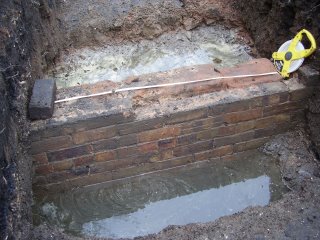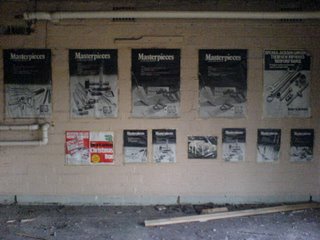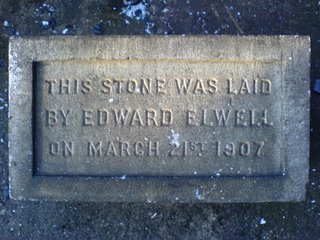Excavations at Bridgnorth
After the problems with flooding a couple of weeks ago the river levels have now dropped and so we have been able to get on with work. The main aim of the trench has been to try and find the line of a former bylet. We were successful in locating the eastern edge of this feature, which was marked by a revetment wall.
 Keith recording the trench section. He is standing on the line of the former bylet, with the revetment wall in the foreground.
Keith recording the trench section. He is standing on the line of the former bylet, with the revetment wall in the foreground.
The wall itself is made of sandstone blocks, which are ashlared on the western (river front) side. However the wall has also been given a front facing of brickwork which protects the relatively soft stone from erosion. The brick facing is quite late, but we have recovered an earlier brick from the core of the wall.
 Detail of the wall const- ruction, from the river side.
Detail of the wall const- ruction, from the river side.
We have found a wide range of artefacts, including nineteenth century bottles and drying floor tiles from the period when the site was in use as a malthouse. We have also recovered a number of earlier pieces, including seventeenth century slipware and tin-glazed earthenware. Photos of the finds will be posted once cleaning and cataloguing is completed.
 Keith recording the trench section. He is standing on the line of the former bylet, with the revetment wall in the foreground.
Keith recording the trench section. He is standing on the line of the former bylet, with the revetment wall in the foreground. The wall itself is made of sandstone blocks, which are ashlared on the western (river front) side. However the wall has also been given a front facing of brickwork which protects the relatively soft stone from erosion. The brick facing is quite late, but we have recovered an earlier brick from the core of the wall.
 Detail of the wall const- ruction, from the river side.
Detail of the wall const- ruction, from the river side.We have found a wide range of artefacts, including nineteenth century bottles and drying floor tiles from the period when the site was in use as a malthouse. We have also recovered a number of earlier pieces, including seventeenth century slipware and tin-glazed earthenware. Photos of the finds will be posted once cleaning and cataloguing is completed.






